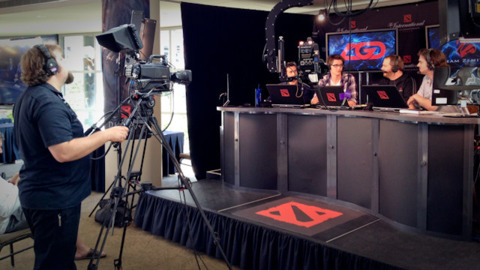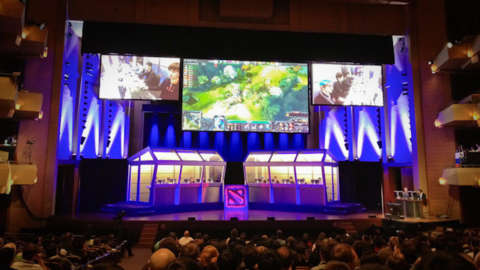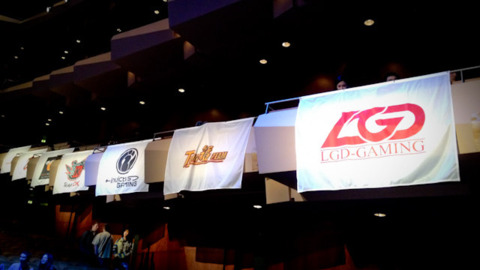23.1 hours. According to Steam, that's how much time I've spent playing Dota 2 since getting my feet wet two weeks ago. As much as I've learned in that time, I know I've only scratched the surface of what this bewildering mash-up of strategy, tower defense, and action-RPG has to offer.
Dota 2 is a lot of things. It's complex, obtuse, frustrating, and deeply rewarding. Together, that's what makes it so brilliant. This is a game where strategies spawn sub-strategies, where your success comes not so much from how you build your house of cards but by how deftly and in what order you can catch the falling pieces. I'm terrible at it. I know this. And that's precisely why I was drawn to The International during PAX this past weekend.
Now in its second year, The International is Valve's official Dota 2 tournament, featuring a million dollar prize for the winning team and a not-too-shabby $250,000 consolation for the runners up. What brought me there wasn't so much an interest in eSports--the concept of competitive gaming had always flown over my head--but rather the belief that if I could learn a few lessons while watching these pro teams, surely I'd go home a better player. In the end, though, I learned about a lot more than protecting my team's base.
When I first walk into the lobby of Benaroya Hall, home of the Seattle Symphony, I see a massive crowd being pulled in all directions. A four-man broadcast stage analyzes every last occurrence from the previous match. A merchandise table beckons fans to buy a branded mousepad, or an inflatable axe, or a plush donkey. Me, I'm just trying to find out where in the hell the entrance to the auditorium is.

I approach the person closest to me, a friendly-looking kid in sandals and jean shorts who, for some reason, seems to be doodling on a Dota 2 poster. Just before I can ask him where the entrance is, he hands the poster to an excited fan and wraps his arm around someone just as a camera flashes a few feet away. Later, while looking through the tournament guide, I realize he's actually a member of mTw, the team that finished first in the International West Qualifiers. I awkwardly slide away, deciding I should probably pose my question to someone who isn't being mobbed for pictures and autographs.
An hour ago I was in the lobby of the Hyatt killing time before an interview. Players from the Anaheim Angels, visiting Seattle to play a series against the Mariners, were waiting around before heading off to the game. Among this group was Albert Pujols, the greatest player of the past decade and a man the Angels recently signed to a 240-million-dollar contract. In the 10 minutes I stood around watching PAX attendees flood through the lobby to get to the convention center, not a single person approached those players.
Valve is an inscrutable company. Trying to decipher the logic behind its moves has become a sort of game in itself, with every new announcement met by a storm of interpretations and conspiracy theories. When Dota 2 was announced, the question at the time was where Valve's sudden interest in the MOBA genre came from. And now that people have an idea of just how eerily similar Dota 2 is to its predecessor, you can't help but wonder why Valve would go through the trouble of making a sequel at all.
Because it's not a sequel. At least not in the traditional sense. Dota 2 is Valve's attempt at taking a highly competitive game and making it highly watchable, all while keeping the original formula intact. It's Valve outwardly acknowledging that eSports is a force to be reckoned with, and boy do they ever want in.
Watch a game in person and it clicks. Broadcasters--or "shoutcasters," to use the appropriate jargon--aren't simply describing the action; they're using a toolset to paint a vivid picture. Bar charts pulled up on the fly show each player's net worth in terms of gold collected, while line graphs show which side has been earning XP at the faster rate. Panels crammed with stats are summoned onto the screen to illustrate a point, then quickly dismissed so the shoutcaster can use the mouse to draw telestrator-style notes onscreen. It's action and information dancing together in a carefully orchestrated ballet.
For these broadcasters--the ones whose screens adorn the halls of The International--Dota 2's spectator mode isn't a passive thing; it's a toolset that allows you to be nearly as active as the players themselves. And for us, the viewers, the result is like watching a game of college football on ESPN. There's a game on, sure, but half the fun is in the presentation.
The crowd is electric. They're cheering, they're on their feet, they're waving national flags. At one point I wonder what new patch added a loud horn every time a hero dies, and then I realize someone in the crowd has brought in one of those mind-shattering vuvuzela horns made famous by the 2010 World Cup. It's South Africa all over again.
What astonishes me most is how familiar the crowd is with every last nuance of the competition. It's as though they've pooled together their collective knowledge of not only the game, but the competitors as well.

The pre-match hero draft has every right to be a dull, tedious affair. It's the process by which teams huddle together to first decide which heroes they want to ban the other team from choosing, followed by which ones they choose themselves. I keep thinking to myself that this part of the game should be like watching a coin flip before a football game, or a tip-off in basketball. But it's not. Players erupt into cheers when a favorite hero is selected, or boo when one is banned.
At one point the announcers can't stop mentioning how good the Chinese teams play with Morphling, a versatile ranged hero whose water abilities excel at taking on other heroes head-to-head. Team Zenith needs to ban him against LGD Gaming, they say. They can't afford not to ban him. They don't ban him. And when LGD inevitably chooses Morphling, the crowd loses its mind.
Then there are the unorthodox tactics, the moves you rarely see in ordinary competition. Team Zenith does this thing where they take a pair of heroes and hide in the trees. Obscured by the fog of war, LGD can't see those Zenith players when they roll through their lane. That's when Zenith pops out from the trees for a surprise gank (a hero kill, essentially). One member of LGD goes down. Another puts up a fight, but quickly falls. The crowd is at a fever pitch. It's the loudest I've heard them cheer.
Yet for all the energy in the crowd, the competitors are almost certainly oblivious to it. As a way of keeping the players from hearing what the announcers might reveal about the competition, each team is sealed up in a soundproof glass booth. It feels like a magic show, 10 lovely assistants submerged in tanks of water before making a daring escape. All that cheering, and none of it gets through.
A Dota 2 match ends when one team destroys the other's ancient, the defensive centerpiece buried deep within each team's base. It should be a moment of triumph: the sight of one team's heroes and creeps hammering away at the ancient while the other team desperately fights to push them away. In reality, it's about the most anticlimactic part of the match.
So much of the focus leading up to this point falls on the little things. A player uses a town portal scroll to return to safety a 10th of a second before getting killed; another destroys his own tower to deny his enemy the gold required to fully upgrade that powerful item in his inventory. Dota 2 is nothing if not a game of details.
The crowd and players are so deeply engrossed in these minute machinations that by the time one team begins to home in on the other's ancient, nobody cares. In fact, every match I watch ends with the losing team disconnecting as soon as they see their own blood in the water. No one sticks around to watch their ancient fall.
As someone who grew up watching the usual trio of American sports--baseball, football, basketball--I keep searching for metaphors. At first, finding parallels with traditional sports is easy. The broadcast setup at The International wouldn't look out of place at the Super Bowl. The people who cheer teams on by waving national flags. That obnoxious vuvuzela.

But the more time I spend watching these matches, the less I understand. Cheering on players who can't hear a single thing, a team investing everything they have for 70 minutes just to disconnect with 10 seconds left. These are things that would never happen in traditional sports.
And yet the crowd couldn't care less They're on their feet for half the match, applauding esoteric strategies and bombastic kills alike. They have their favorite teams, their favorite players, and it doesn't matter to them one bit whether the whole thing feels like a game of football or basketball. They're Dota 2 fans here to watch people who are really, really good at Dota 2.
Maybe the phrase "eSports" is a misnomer. Maybe people like me, the ones searching for parallels to help better understand a culture they don't fully understand, have been doing it wrong this whole time. Who knows? By the last day of the tournament, I don't really care. I've left Seattle and flown home to San Francisco with my new plush donkey stashed away in my suitcase. At home in my apartment, I'm not playing Dota 2. I'm not trying out the new strategies I've learned. I'm right there in spectator mode watching the conclusion of The International, because like everyone else back in that auditorium, I just want to see who wins this tournament.